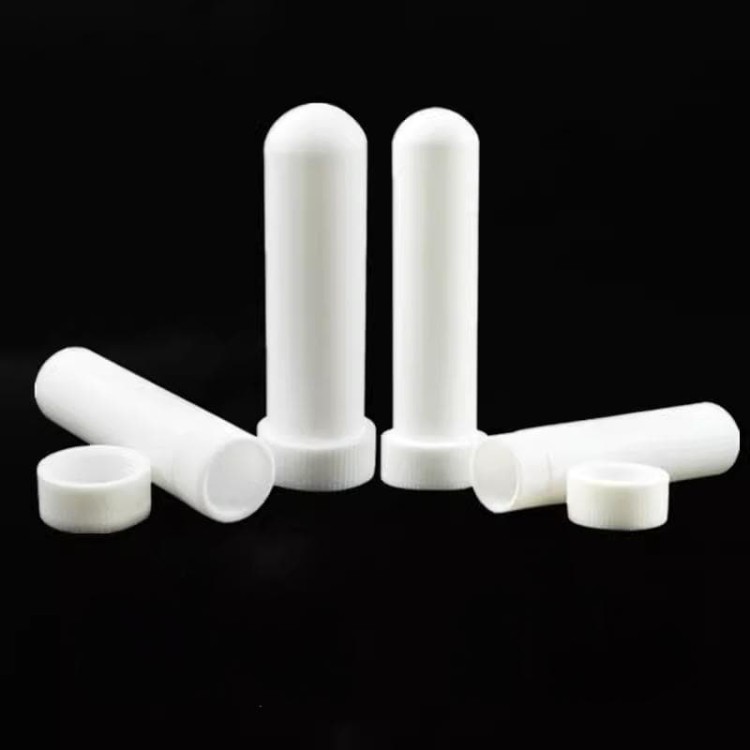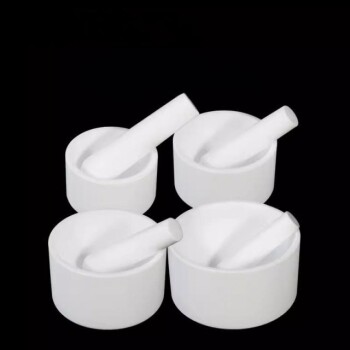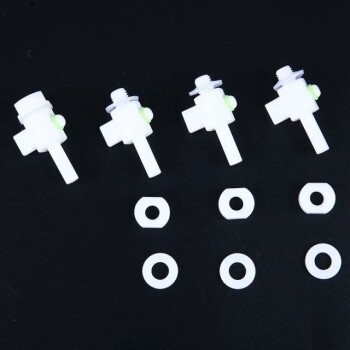
PTFE material
Custom PTFE Teflon Parts Manufacturer for Centrifuge Tubes
Item Number : PTFE-32
Price varies based on specs and customizations
- Material
- PTFE
- Specification
- See the form
Shipping:
Contact us to get shipping details Enjoy On-time Dispatch Guarantee.
Why Choose Us
Reliable PartnerEasy ordering process, quality products, and dedicated support for your business success.
Introduction
PTFE centrifugal tubes are an essential component in various laboratory settings, particularly where high resistance to chemicals and temperature is required. These tubes are designed to withstand harsh conditions, making them ideal for applications in chemical and biological research.
- Chemical Resistance: PTFE centrifugal tubes are highly resistant to a wide range of chemicals, including strong acids and bases. This feature makes them suitable for use in environments where exposure to corrosive substances is common, ensuring the integrity of samples and the longevity of the tubes.
- Temperature Tolerance: These tubes can withstand extreme temperatures, from -100°C to 260°C. This capability allows for their use in various temperature-controlled experiments, ensuring stability and reliability in high and low-temperature applications.
- Non-Stick Surface: The non-stick property of PTFE ensures that samples do not adhere to the tube walls, facilitating easy release and preventing cross-contamination between different samples. This feature is crucial in maintaining the purity and accuracy of experimental results.
Details & Parts









Technical specifications
| Model | Outer diameter(mm) | Total height(mm) | Wall thickness(mm) | |
|---|---|---|---|---|
| screw mouth round bottom | 5ml | 16 | 65 | 2 |
| 10ml | 16 | 125 | 2 | |
| 15ml | 20 | 100 | 2.5 | |
| 20ml | 20 | 125 | 2.5 | |
| 25ml | 25 | 105 | 2.5 | |
| 30ml | 25 | 125 | 2.5 | |
| 40ml | 28 | 105 | 2 | |
| 45ml | 28 | 120 | 2 | |
| 50ml | 33 | 115 | 2.5 | |
| 100ml | 35 | 150 | 3.5 | |
| 100ml | 36 | 145 | 3 | |
| screw mouth flat bottom | 5ml | 16 | 55 | * |
| 10ml | 16 | 108 | * | |
| 20ml | 22 | 106 | * | |
| 30ml | 25 | 124 | * | |
| 50ml | 30 | 125 | * | |
| 100ml | 39 | 139 | * |
The size is for reference only, please refer to the actual product.
Applications
- Chemical Industry: Utilized in pipeline systems for transporting corrosive liquids and gases, as well as in the manufacture of valves, pumps, and reactor liners.
- Pharmaceutical and Biomedical Fields: Ideal for sterile and clean fluid delivery pipelines in biopharmaceutical processes, and also used in medical devices such as catheters and implants.
- Semiconductor and Electronics Industry: Essential in electronic component cooling systems and for ultrapure water delivery due to their superior insulation properties.
- Laboratory Research: Commonly used in laboratories for centrifugation processes involving aggressive chemicals or high temperatures, ensuring safety and precision.
- Environmental Analysis: Used in the analysis of environmental samples where resistance to harsh chemicals and stability at varying temperatures is crucial.
- Food and Beverage Industry: Due to their non-reactive nature and ability to withstand high temperatures, they are used in processes that require strict hygiene and chemical inertness.
Designed for You
KinTek provide deep custom made service and equipment to worldwide customers, our specialized teamwork and rich experienced engineers are capable to undertake the custom tailoring hardware and software equipment requirements, and help our customer to build up the exclusive and personalized equipment and solution!
Would you please drop your ideas to us, our engineers are ready for you now!
FAQ
What Are The Main Advantages Of Using PTFE Centrifugal Tubes?
Can PTFE Centrifugal Tubes Be Used With Any Type Of Centrifuge?
Are PTFE Centrifugal Tubes Suitable For Use In Biological Applications?
What Is The Maximum Pressure That PTFE Centrifugal Tubes Can Withstand?
What Types Of Samples Are Suitable For Centrifugation In PTFE Tubes?
What Is A Thermal Element?
How Does A Thermal Element Work?
What Are The Advantages Of Using Thermal Elements?
What Are The Different Types Of Thermal Elements?
How Should Thermal Elements Be Calibrated And Maintained?
4.8
out of
5
Exceptional durability!
4.7
out of
5
Highly resistant to chemicals.
4.9
out of
5
Temperature tolerance is impressive.
4.6
out of
5
Non-stick surface is a game-changer.
4.8
out of
5
Excellent for high-heat experiments.
4.7
out of
5
Sterilization is quick and easy.
4.9
out of
5
Optical clarity aids in observation.
4.6
out of
5
Great for biocompatibility tests.
4.8
out of
5
Resists wear and tear effectively.
4.7
out of
5
Ideal for harsh laboratory conditions.
4.9
out of
5
Versatile and reliable in various applications.
4.6
out of
5
Excellent value for money.
REQUEST A QUOTE
Our professional team will reply to you within one business day. Please feel free to contact us!
Related Products

Custom PTFE Teflon Parts Manufacturer for Centrifuge Tube Racks
The precision-made PTFE test tube racks are completely inert and, due to the high temperature properties of PTFE, these test tube racks can be sterilized (autoclaved) without any problems.

Custom PTFE Teflon Parts Manufacturer for PTFE Measuring Cylinder 10/50/100ml
PTFE measuring cylinder are a rugged alternative to traditional glass cylinders. They are chemically inert over a wide temperature range (up to 260º C), have excellent corrosion resistance and maintain a low coefficient of friction, ensuring ease of use and cleaning.

Custom PTFE Teflon Parts Manufacturer for PTFE Containers
PTFE container is a container with excellent corrosion resistance and chemical inertness.

Custom PTFE Teflon Parts Manufacturer for Gaskets and More
Gaskets are materials placed between two flat surfaces to enhance the seal. To prevent fluid leakage, sealing elements are arranged between static sealing surfaces.

Custom PTFE Teflon Parts Manufacturer for PTFE Tweezers
PTFE tweezers inherit the excellent physical and chemical properties of PTFE, such as high temperature resistance, cold resistance, acid and alkali resistance, and corrosion resistance to most organic solvents.

Custom PTFE Teflon Parts Manufacturer PTFE Beaker and Lids
The PTFE beaker is a laboratory container that is resistant to acid, alkali, high and low temperatures and is suitable for temperatures ranging from -200ºC to +250ºC. This beaker has excellent chemical stability and is widely used for heat treatment samples and volume analysis.

Custom Machined and Molded PTFE Teflon Parts Manufacturer with PTFE Crucible and Lid
PTFE crucibles, made from pure Teflon, offer chemical inertness and resistance from -196°C to 280°C, ensuring compatibility with a wide range of temperatures and chemicals. These crucibles feature machine-finished surfaces for easy cleaning and prevention of contamination, making them ideal for precise laboratory applications.

Custom PTFE Teflon Parts Manufacturer for PTFE Buchner Funnel and Triangular Funnel
The PTFE funnel is a piece of laboratory equipment used primarily for filtration processes, particularly in the separation of solid and liquid phases in a mixture. This setup allows for efficient and rapid filtration, making it indispensable in various chemical and biological applications.

Custom PTFE Teflon Parts Manufacturer Grinding Bowl
PTFE is renowned for its exceptional chemical resistance, thermal stability, and low friction properties, making it a versatile material in various industries. The PTFE grinding bowl, specifically, finds applications where these properties are crucial.

Custom PTFE Teflon Parts Manufacturer for PTFE Ball Valve Seat
Seats and inserts are vital components in the valve industry. As a key component, polytetrafluoroethylene is usually selected as the raw material.

Custom PTFE Teflon Parts Manufacturer F4 Conical Flask Triangular Flask 50 100 250ml
The PTFE triangular flask, also known as a Teflon reagent bottle, is a robust, chemical-resistant alternative to traditional glass bottles, suitable for handling both acids and alkalis. These bottles are unbreakable, lightweight, and feature a leak-proof screw cap, making them ideal for laboratory use.

Custom PTFE Teflon Parts Manufacturer for Air Valve Applications
PTFE small air valve for gas-liquid sampling and sampling bag for sample collection.

Custom PTFE Teflon Parts Manufacturer for Three-Necked Round Bottom Flask
PTFE flask, is a versatile laboratory container made from PTFE, offering exceptional chemical resistance, temperature stability, and non-stick properties. Ideal for handling corrosive substances and high-temperature applications, these flasks are essential in various laboratory procedures, including heating, mixing, and storage of chemicals.

Custom PTFE Teflon Parts Manufacturer Laboratory High Temperature Mixing Paddle Mixer
The PTFE mixing paddle mixer is a versatile and robust tool designed for laboratory use, particularly in environments requiring high resistance to chemicals and extreme temperatures. Crafted from high-quality PTFE, this mixer boasts several key features that enhance its functionality and durability.

Custom PTFE Teflon Parts Manufacturer for PTFE Stirring Bar Recovery Rod
This product is used for stirrer recovery, and is resistant to high temperature, corrosion, and strong alkali, and is almost insoluble in all solvents. The product has a stainless steel rod inside and a polytetrafluoroethylene sleeve outside.

Custom PTFE Teflon Parts Manufacturer for PTFE Bottle Oil Fume Sampling Tube
PTFE products are generally called "non-stick coating", which is a synthetic polymer material that replaces all hydrogen atoms in polyethylene with fluorine.

PTFE cleaning racks are mainly made of tetrafluoroethylene. PTFE, known as the "King of Plastics", is a polymer compound made of tetrafluoroethylene.

Custom PTFE Teflon Parts Manufacturer for Cleaning Racks
PTFE cleaning racks are mainly made of tetrafluoroethylene. PTFE, known as the "King of Plastics", is a polymer compound made of tetrafluoroethylene.

Custom PTFE Teflon Parts Manufacturer for F4 PTFE Volumetric Bottle
The PTFE Volumetric Flask, a robust alternative to glass and PP flasks, excels in measuring both acidic and alkaline liquids. Characterized by its chemical inertness, translucency, and wide volume options, this flask ensures a non-leachable, ultra-clean background. Its non-stick surface simplifies cleaning and maintenance, making it ideal for harsh laboratory conditions.
Related Articles

Exploring the Multifunctional Electrolytic Cell Water Bath: Applications and Benefits
Discover the versatile applications of multifunctional electrolytic cell water baths in various industries. Learn about their benefits, components, and how they facilitate chemical reactions and temperature control.

Manual Hydraulic Presses for Laboratory Use: A Comprehensive Guide
Explore the intricacies of manual hydraulic presses in labs, including operation, benefits, and comparison with automatic models. Ideal for those seeking detailed insights on sample preparation and cost-effectiveness.

Chemical Vapor Deposition (CVD) Process and High Purity PFA Tubing
An overview of the CVD process and the role of high purity PFA tubing in semiconductor manufacturing.

The Crucible's Choice: Why Your Furnace Tube Material Defines Experimental Success
Selecting a furnace tube is a critical trade-off between thermal resilience, chemical purity, and operational integrity. Make the right choice.

The Architecture of Isolation: Anatomy of a Tube Furnace
Explore the layered engineering of a tube furnace. From alumina insulation to quartz reactors, understand how this "thermal sleeve" achieves precise isolation.

The Architecture of Heat: Why Precision is the Only Variable That Matters
A tube furnace is more than an oven; it is a system of isolation and control. Explore the engineering behind thermal uniformity and atmosphere management.

Cracked Tubes, Contaminated Samples? Your Furnace Tube Is The Hidden Culprit
Frustrated by failed experiments? Learn why your furnace tube material—not your process settings—is the critical variable causing inconsistent results.

Basic Laboratory Centrifuge Equipment
Overview of different types of centrifuges used in laboratories.

The Transparency Paradox: Mastering the Art of Quartz Tube Maintenance
In high-temperature furnaces, cleanliness is physics, not just aesthetics. Discover the systematic approach to cleaning quartz tubes and the critical role of prevention.

The Architecture of Isolation: Mastering the Anatomy of a Tube Furnace
A tube furnace is more than a heater; it is a modular system for isolation. Explore the engineering behind quartz vs. alumina, thermal zones, and atmospheric control.

Understanding and Selecting the Right Microplates for Laboratory Applications
Guide to choosing microplates based on pore density, materials, colors, well shapes, and surface finishes for various laboratory applications.

Entropy and the Alumina Tube: The Art of Precision Maintenance
Discover the disciplined approach to cleaning alumina furnace tubes. Learn how to prevent thermal shock, remove residue with acid, and extend equipment life.